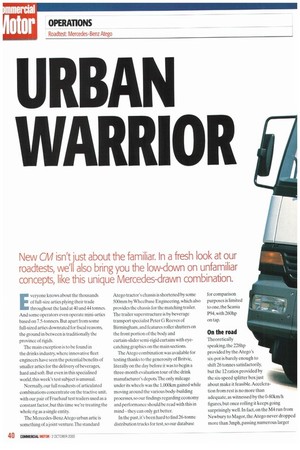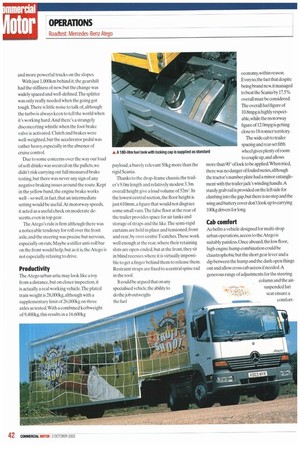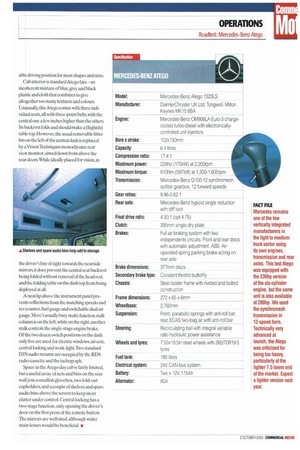URBAN
Page 40

Page 42

Page 43

If you've noticed an error in this article please click here to report it so we can fix it.
WARRIOR
New CM isn't just about the familiar. In a fresh look at our roadtests, we'll also bring you the low-down on unfamiliar concepts, like this unique Mercedes-drawn combination.
Everyone knows about the thousands of full-size artics plying their trade throughout the land at 40 and 44 tonnes. And some operators even operate mini-artics based on 7.5-tonners. But apart from some full-sized artics downrated for fiscal reasons, the ground in between is traditionally the province of rigids.
The main exception is to be found in the drinks industry, where innovative fleet engineers have seen the potential benefits of smaller artics for the delivery of beverages, hard and soft. But even in this specialised world, this week's test subject is unusual.
Normally, our full roadtests of articulated combinations concentrate on the tractive unit. with our pair of Fruehauf test trailers used as a constant factor, but this time we're treating the whole rig as a single entity.
The Mercedes-BenzAtego urban artic is something of a joint venture.The standard Atego tractor's chassis is shortened by some 500mm by Wheelbase Engineering, which also provides the chassis for the matching trailer. The trailer superstructure is by beverage transport specialist Peter G Reeves of Birmingham. and features roller shutters on the front portion of the body and curtain-slider semi-rigid curtains with eyecatching graphics on the main sections.
The Atego combination was available for testing thanks to the generosity of Britvic. literally on the day before it was to begin a three-month evaluation tour of the drink manufacturer's depots.The only mileage under its wheels was the 1.000km gained while moving around the various body-building processes, so our findings regarding economy and performance should be read with this in mind — they can only get better.
In the past, it's been hard to find 26-tonne distribution trucks for test, so our database for comparison purposes is limited to one, the Scania P94, with 260hp on tap.
On the road Theoretically speaking, the 228hp provided by the Atego's six-pot is barely enough to shift 26 tonnes satisfactorily, but the 12 ratios provided by the six-speed splitter box just about make it feasible. Acceleration from rest is no more than adequate, as witnessed by the 0-80km/h figures, but once rolling it keeps going surprisingly well. In fact, on the M4 run from Newbury to Magor, the Atego never dropped more than 3mph, passing numerous larger and more powerful trucks on the slopes.
With just 1.000km behind it, the gearshift had the stiffness of new, but the change was widely spaced and well-defined. The splitter was only really needed when the going got tough.There is little noise to talk of, although the turbo is always keen to tell the world when it's working hard.And there's a strangely disconcerting whistle when the foot brake valve is activated. Clutch and brakes were well-weighted,but the accelerator pedal was rather heavy especially in the absence of cruise control.
Due to some concerns over the way our load of soft drinks was secured on the pallets, we didn't risk carrying out full measured brake testing, but there was never any sign of any negative braking issues around the route. Kept in the yellow band, the engine brake works well — so well, in fact, that an intermediate setting would be useful. At motorway speeds, it acted as a useful check on moderate descents, even in top gear.
The Atego's ride is firm although there was a noticeable tendency for roll over the front axle, and the steering was precise but nervous, especially on ruts. Maybe a stiffer anti-roll bar on the front would help, but as it is, the Atego is not especially relaxing to drive.
Productivity
The Atego urban artic may look like a toy from a distance, but on closer inspection. it is actually a real working vehicle. The plated train weight is 28,000kg, although with a supplementary limit of 26,000kg on three axles as tested.With a combined kerbweight of 9,400kg, this results in a 16,600kg payload,a barely relevant 50kg more than the rigid Scania.
Thanks to the drop-frame chassis, the trailer's 9.0m length and relatively modest 3.3m overall height give a load volume of 52m. In the lowest central section, the floor height is just 610mm, a figure that would not disgrace some small vans.The false floor at the rear of the trailer provides space for air tanks and storage of straps and the like. The semi-rigid curtains are held in place and tensioned, front and rear, by over-centre 1-catches. These work well enough at the rear, where their retaining slots are open-ended. but at the front, they sit in blind recesses where it is virtually impossible to get a finger behind them to release them. Restraint straps are fixed to a central spine rail in the roof.
It could be argued that on any specialised vehicle, the ability to do the job outweighs the fuel economy,within reason. Even so,the fact that despite being brand new, it managed to beat the Scania by 17.5% overall must be considered. The overall fuel figure of 10.8mpg is highly respectable,while the motorway figure of 12.0mpg is getting close to 18-tormer territory.
The wide cab to trailer spacing and rear-set fifth wheel gives plenty of room to couple up. and allows more than 900 of lock to be applied.When tried, there was no danger of fouled suzies,although the tractor's number plate had a minor entanglement with the trailer jack's winding handle.A sturdy grab rail is provided on the left side for climbing into the gap, but there is no step and the wing and battery cover don't look up to carrying 100kg drivers for long.
Cab comfort
As befits a vehicle designed for multi-drop urban operations, access to the Atego is suitably painless. Once aboard, the low floor, high engine hump combination could be claustrophobic but the short gear lever and a dip between the hump and the dash open things out and allow cross cab access if needed.A generous range of adjustments for the steering column and the airsuspended Isri seat ensure a comfort
able driving position for most shapes and sizes.
Cab interior is standard Atego fare — an incoherent mixture of blue, grey and black plastic and cloth that combines to give altogether too many textures and colours. Unusually,thisAtego comes with three individual seats all with three-point belts, with the central one a few inches higher than the others. Its backrest folds and should make a (highish) table top. However,the usual removable litter bin on the left of the central dash is replaced by a Vision Techn iques monochrome rear view monitor, aimed down from above the rear doors. While ideally placed for vision,in
the driver's line ut sight towards the nearside mirrors,it does prevent the central seat backrest being folded without removal of the head rest, and the folding table on the dash top from being deployed at all.
A neat lip above the instrument panel prevents reflections from the matching speedo and rev counter, fuel gauge and switchable dual air gauge. Merc's usually busy multi-function stalk column is on the left, while on the right,another stalk controls the single-stage engine brake. Of the two dozen switch positions on the dash only five are used,for electric windows, air-con, central locking and work-lig,ht.Two standard DIN audio mounts are occupied by the RDS radio-cassette and the tachograph.
Space in the Atego day cab is fairly limited, but a useful array of nets and bins on the rear wall join a smallish glovebox, two fold-out cupholders, and a couple of shelves and spare audio bins above the screen to keep most clutter under control. Central locking has a two-stage function, only opening the driver's door on the first press of the remote button. The mirrors are well sited, although wider main lenses would be beneficial. •




























































































































































































